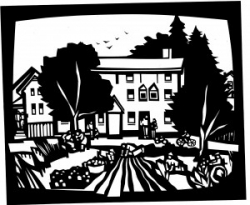Feb
17
2017

Written by Noelia Mann
As anyone who has ever lived (or tried to live) in New York City knows, rent price tags are no joke. In NYC, chronic disinvestment in communities of color, and rampant gentrification are just a few of the issues that keep driving prices sky high and forcing long-term residents out of their homes. City officials have tried a number of affordable housing programs, ranging from co-ops to rent stabilization regulations, but the demand for genuinely affordable housing remains far higher than the supply. In fact, New York City has the highest percentage of rent burden in the country, followed by Detroit, MI. As activists in both cities push back against land grabs by outside speculators and try to establish community control over land use decisions, New Yorkers and Detroiters have come to a similar solution: the Community Land Trust (CLT) model.
Community Land Trusts are legal arrangements to ensure permanent affordability. The basic idea is to take land out of the speculative market and put it back into the hands of the community. To do this, land ownership and property ownership of homes on that land are legally separated. The land ownership is transferred to a nonprofit entity – the land trust – created for the specific purpose of owning the land title and enforcing the terms of the ground lease, which contains provisions to ensure permanent affordability. The community elects the members of a land trust boards, with a third of the seats filled by existing owners of homes on land leased from the CLT; a third by residents from the surrounding community; and, a third by public officials or other supporters of the CLT. Through this “tripartite” structure, the boards return control over land use to the community. Homes on the land-trust can then be bought, but do not include the price of the land, offering low and moderate-income families and first time homeowners a viable option to ownership. The land is then leased by homeowners from the CLT, and that lease contains limitations on resale prices which preserve affordability in perpetuity.
The CLT model has been around for a long time, but it wasn’t until the 1990s that the CLT movement really started to flourish in the U.S. Indeed, from 2000 to 2011, the numbers of CLTs grew from 90 to 242. Detroit’s first CLT was established by the Storehouse of Hope in October 2015 in response to the foreclosure nightmare that had 60,000 properties facing tax foreclosure in 2015. The Storehouse of Hope hopes that the CLT will be a strong antidote to rising prices and the disenfranchisement of long-time residents under Detroit’s current development efforts.
There are still substantial challenges keeping the model from taking off. Linda Campbell from the Detroit People’s Platform, which helped form the Detroit Community Land Trust Coalition and launch the Storehouse of Hope CLT, says that a major barrier is the cultural issue of homeownership in Detroit. Before the subprime mortgage crisis, Detroit enjoyed one of the nation’s highest rates of homeownership. Of this phenomenon, Ta-Nehisi Coates wrote for the Atlantic, “Homeownership is a religion in America, but the fanatics of Detroit are without peer…Detroit is the only city in the country where more African-Americans own homes than rent. Only in Detroit does the African-American homeownership rate (53 percent) approach the national white homeownership rate (56 percent).” CLT homeowners do own their homes, but they don’t own the land upon which their homes stand and must agree to certain limitations regarding resale. Campbell explains that this can offer a psychological challenge, especially to Black Americans, “for whom owning the land has historically been an important proxy for freedom.” She adds, “The idea and philosophy has really caught on over the last 3-5 years, but it’s all about changing the culture… it’s hard for people to make that mental transition.” Furthermore, Campbell notes that mortgages are nearly impossible to come by in Detroit these days, so the communities that most need the benefits of CLTs- low-income and working communities of color- are least likely to qualify for ownership, a core tenant of the traditional CLT model.
A similar tension exists in NY. At the root of this conflict is the ongoing notion that homeownership is a pathway to wealth; there is uncertainty with shared equity models, like the CLT, which place restrictions ownership, such as resale profitability and land lease. As a result, in cities like NY, Detroit, and many more, traditional market based approaches to housing affordability, such as inclusionary zoning, tax credits, and abatements have more visibility and are often the go-to. NY has been slow to jump on the CLT bandwagon for a few other reasons as well. To begin with, public land in NYC is scarce and the price of private land is high, making CLTs difficult and costly to establish. Another problem is that the DeBlasio administration is so eager to reach its promised goal of 200,000 new affordable housing units that it is opting for the easiest and most familiar solution: providing subsidies to a few favorite for-profit affordable housing developers.
Despite the odds, on Monday, Jan 9, the DeBlasio administration released a Request for Expressions of Interest (RFEI) for groups interested in forming community land trusts using city-owned property. This request represents a major win for grassroots organizers who have been working to promote CLTs in NYC for decades. Yet, as UHAB staffer Melanie Berkowitz pointed out to me, the RFEI clearly exonerates the city of any responsibility to follow up on the proposals it receives, publish the results of its findings, or even respond to submissions. Nevertheless, the RFEI is a powerful indicator that the efforts by local NY coalitions, like NYCCLI, and its counterparts, like the Detroit Community Land Trust Coalition, have not been in vain, and are making meaningful contributions to ensuring affordable housing in American cities.
